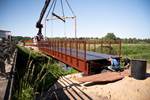European associations seek to up-scale cement coprocessing for composites
Industry partners call on policymakers to support the recycling process in the EU for end-of-life composite materials, facilitate further decarbonization and circularity.
Working together to increase the circularity of composite materials, European-based WindEurope, the European Composites Industry Association (EuCIA), Cembureau (European Cement Association), the European Boat Industry (EBI), Cefic UP/VE Resin Association, Cefic Epoxy Europe and Glass Fibre Europe, have published a statement highlighting the important role cement coprocessing can play in treating end-of-life (EOL) composite materials.
The seven industry associations call on policymakers to recognize these benefits and facilitate the upscaling of coprocessing as a recycling process with a more supportive EU regulatory framework, to enable the EU to foster industry growth and ensure a circular future for the cement and composite material sectors, both of which are extensive.
Recycling EOL composite materials — separating the constituent fibers and polymers — still remains a technical challenge (read “Moving toward next-generation wind blade recycling” for examples in the wind industry). Cement coprocessing is said to offer a sustainable and circular solution. The process enables comprehensive recycling glass fiber composites, while mitigating climate change through the reduction of natural raw materials in cement manufacturing and the replacement of fossil energy sources.
The seven associations are further collaborating to promote sustainable recycling approaches for EOL composite materials with more actions planned in the coming months.
The joint Position Paper is available to download from the Publications section of the EuCIA website.
Related Content
-
Plant tour: Joby Aviation, Marina, Calif., U.S.
As the advanced air mobility market begins to take shape, market leader Joby Aviation works to industrialize composites manufacturing for its first-generation, composites-intensive, all-electric air taxi.
-
Natural fiber composites: Growing to fit sustainability needs
Led by global and industry-wide sustainability goals, commercial interest in flax and hemp fiber-reinforced composites grows into higher-performance, higher-volume applications.
-
Manufacturing the MFFD thermoplastic composite fuselage
Demonstrator’s upper, lower shells and assembly prove materials and new processes for lighter, cheaper and more sustainable high-rate future aircraft.
















.jpg;maxWidth=300;quality=90)
